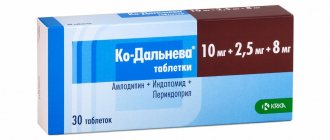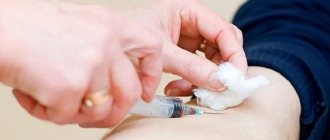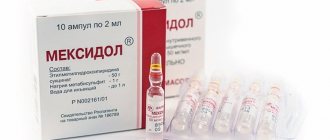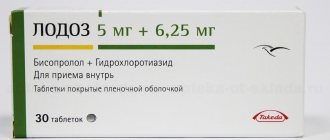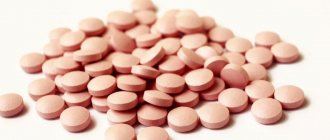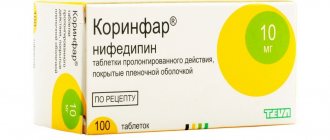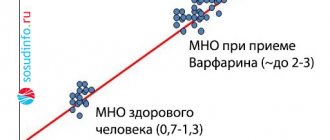A decrease in hemoglobin can occur both physiologically and as a result of disease. The causes of anemia are varied, but they all lead to a deterioration in health, decreased performance, and a general loss of strength. Treatment depends on the degree of anemia. Injections are indicated for moderate to severe blood protein deficiency. Injections are performed intramuscularly or intravenously. The procedure is performed only in a medical facility, since after the injections, mandatory medical supervision is required for half an hour.
Anemia
Causes of iron deficiency
The main reason for the decrease in hemoglobin in the blood is a lack of iron, since it is involved in the synthesis of this blood protein. Iron deficiency is caused by many factors, the main one being impaired absorption of iron molecules by tissues and limited intake into the body. There are external and internal factors for the development of iron deficiency. It becomes a consequence:
- chronic bleeding;
- disorders of iron metabolism in the body;
- increased microelement consumption;
- poor nutrition;
- violation of the absorption function of the gastric tract.
The reasons for the development of such changes are:
- long and heavy menstruation;
- tumor processes in the uterus;
- endometriosis;
- tuberculosis lesion;
- kidney pathologies (KD);
- hypertension, accompanied by frequent nosebleeds;
- erosive gastritis;
- ulcer of the duodenum or stomach;
- hemorrhoidal bleeding;
- neoplasms in the digestive tract;
- helminthiasis;
- stomatitis, gingivitis.
Even minor but prolonged bleeding leads to loss of iron, since the element is not synthesized by the body, but is supplied as part of food. In order not to cause its deficiency, you should eat well. Anemia is often diagnosed in people who prefer vegetarianism or are on a strict diet to lose weight.
Violation of microelement absorption is observed with an unbalanced diet, since there are foods that inhibit its absorption. When compiling a daily menu, you should take into account the compatibility of products. In addition, with chronic inflammation of the gastric tract, its absorption capacity is impaired. That is, food entering the intestines does not “give up” all the beneficial substances, creating a deficiency of vitamins and microelements. The body does not create an iron depot, since its supply decreases.
It is important to know! The reason for increased removal of iron from the body is not always bleeding. Increased evacuation of the microelement is observed during pregnancy, breastfeeding, and systematic intense physical activity.
Symptoms of decreased hemoglobin
Clinical manifestations of hemoglobin deficiency in the body depend on the speed of its decrease.
- Complaints of weakness, fatigue, dizziness, a feeling of blurred vision, shortness of breath during physical activity.
- When examined, the person is pale, sometimes with a greenish tint; attention is paid to the mucous membranes of the mouth and lips.
- Sideropenic syndrome:
- dry skin, cracks,
- hair loss,
- stomatitis,
- muscle weakness,
- increased attention to non-specific odors,
- deviation from the usual taste (they eat plaster, chalk),
- craving for ice (in winter),
- atrophic gastritis.
In older people, anemia is masked by symptoms of concomitant diseases.
What type of iron does a person need?
Iron that enters the body with food is divided into heme and non-heme. The first is found in products of animal origin and is part of animal hemoglobin. It is better absorbed and saturates the tissues with the necessary element faster.
Heme iron
Foods high in heme iron include:
- red meat;
- seafood;
- canned fish;
- eggs.
There is a lot of element in rabbit, veal, lamb, chicken, pork. Beef, chicken and pork liver are also useful products in this regard, as is the heart of these animals. Fish and shellfish are also rich in this trace element. With low hemoglobin in adults, it is useful to eat:
- black caviar;
- salmon;
- sea or river perch;
- mackerel and pike;
- mussels, oysters.
Non-heme iron is found in plant foods. It is poorly absorbed, so such foods must be combined with vitamin C or B12.
Information! When entering the body, heme iron is absorbed by 17-20%, while non-heme iron is absorbed by only 2-5%.
Non-heme iron is found in:
- cereals;
- legumes;
- greenery;
- vegetables and fruits (especially yellow and orange);
- red berries;
- nuts;
- dried fruits;
- sunflower seeds
The maximum amount of organic metal is found in asparagus, Jerusalem artichoke, and garlic. Among fruits, passion fruit, persimmon, dates, and pears hold the lead. Apples do not contain much, but almost all of it is absorbed, since the pulp is rich in vitamin C.
Non-heme iron
Classification of iron-containing drugs, their advantages and disadvantages
The main iron preparations are divided into – salts of di- or trivalent Fe; and non-ionic compounds of ferric iron with a hydroxide-polymaltase complex. Divalent salt preparations are often prescribed to adults to increase hemoglobin. The medication is quickly absorbed in the intestines, enters the blood and accumulates in tissues. When decomposed, they do not form harmful compounds. Trivalent salt products are less easily absorbed. Their absorption directly depends on the acidity of gastric juice. The higher it is, the more poorly soluble complexes are formed, which are toxic to the body.
Non-ionic drugs are modern drugs with a low percentage of adverse reactions. Their mechanism of action is somewhat different from previous agents. This complex is as similar in structure as possible to the structure of the iron-ferritin compound. Absorbed in the intestines, it does not accumulate in tissue cells, but is deposited in the liver, creating an “iron” reserve. If there are already enough iron molecules, then self-regulation mechanisms are activated and excess iron is removed from the body without causing an overdose.
What is anemia
This condition is characterized by a low level of hemoglobin structures. Anemia develops, in which the oxygen supply to tissue cells deteriorates. There are drugs that increase hemoglobin in the human body.
There are several types of anemic conditions in which there is a lack of proteins, iron compounds or cyanocobalamin. The most common form is considered to be iron deficiency anemia, caused by a discrepancy in the need and supply of Fe ions.
There are two levels of the disease:
- Hidden iron deficiency, in which ferritin and hemoglobin concentrations are reduced, as well as transferrin filling, but there are no clinical signs of Fe deficiency.
- Actually an anemic state with obvious characteristics of metal deficiency in human organs, when the formation of hemoglobin molecules is disrupted.
Rules for taking iron supplements
To correct low hemoglobin levels, divalent salt preparations are often prescribed for oral administration. They are recommended to be swallowed without chewing to prevent darkening of the tooth enamel. The therapeutic daily dose of the drug is 100-200 mg; more iron is not absorbed by the body. In addition, the microelement comes not only from medications during the day, but also from food. Therefore, it makes no sense to take large doses of medication. This will not cure anemia faster, but the side effects will appear with full force.
When taking medications, you should not take them with drinks containing:
- phosphoric acid;
- calcium;
- phytin;
- tannin.
These substances interfere with the absorption of iron, so Coca-Cola, tea and coffee are not suitable for washing down tablets.
During therapy, a blood test is taken every 2-3 weeks to determine the level of red blood cells, ferritin, and hemoglobin. If the analysis showed the indicators in the number. You should not stop taking medications right away. It is necessary to continue therapy for another 1-2 months to saturate the body with iron and get a lasting result. Upon completion of the course of therapy, analysis is performed 2-3 months later. To increase the effectiveness of medications, you need to take them together with vitamin C. Ascorbic or folic acid.
Helpful advice! Treatment of anemia with medications containing iron should be combined with the intake of “iron” foods, limiting food that “inhibits” the absorption of the microelement.
Oral iron supplements
This type of drug is intended for oral administration. Products are available in tablets, capsules, syrups and chewable lozenges. They differ in composition, absorption rate, and the presence of side properties, but have the same therapeutic effect. To treat anemia, doctors prefer to prescribe oral medications because they are well absorbed into the gastrointestinal tract and absorption occurs naturally. The physiological process of self-regulation prevents overdose, since as much is absorbed as the body needs.
Iron tablets
Modern developments offer new generation drugs with a prolonged effect. One capsule of the product contains a daily dose of iron. Long-lasting action is ensured by special manufacturing technology. Once in the gastrointestinal tract, the tablet gradually loses iron ions. First, the molecules are released from the top layer, then the capsule gradually dissolves completely, up to 6 hours. This mechanism ensures slow saturation of the body with the microelement without causing an overdose.
Parenteral iron supplements
Prescribing injections to increase hemoglobin is indicated only in extreme cases. The injection method is used in the following cases:
- ineffectiveness of oral agents;
- violations of intestinal absorption capacity;
- urgent need to increase hemoglobin volume (preoperative preparation);
- the appearance of adverse reactions that make further therapy impossible.
Parenteral medications that increase iron levels are administered intramuscularly or intravenously. IVs are given 12 times a week, depending on the degree of anemia. Intramuscular injections are performed daily. The dosage of injections is calculated individually, taking into account the patient’s condition, the degree of iron deficiency, and the presence of concomitant diseases.
Injections to raise hemoglobin levels and names of drugs
When administering drugs parenterally, regular monitoring of blood counts is required. Iron injections will quickly raise hemoglobin levels, so therapy should be monitored by clinical tests. In addition, therapy must take place in a hospital, since this method of administration has a high threshold for the development of complications. The products are produced in ampoules containing no more than 100 mg of active iron, with a capacity of 1,2 or 5 ml.
| Name | Method of administration | Ampoule capacity |
| Dextrafer | in\in | 2,0 |
| Lickferr | in\in | 5,0 |
| Ferum Lek | in\m | 2,0 |
| Maltofer | in\m | 2,0 |
Ferric iron is used for injections. It is poorly absorbed into the gastrointestinal tract and forms poorly soluble compounds. Often causes the development of side symptoms in patients.
Iron injections
The use of iron-containing medications by pregnant and lactating women
The period of bearing a child is very important, so every woman is scrupulous about the choice of medications for the treatment or prevention of anemia. After all, this pathology is diagnosed in almost a third of pregnant women. Prescription of products with iron during pregnancy is indicated in the case when the body cannot cope with the function of accumulating the microelement, since as the period grows, the need also increases.
If the supply of organic matter with food does not meet the body's needs, medications are prescribed to replenish Fe deficiency. But many “iron” drugs have not undergone proper laboratory testing and their safety for pregnant women has not been confirmed. Therefore, treatment of anemia with injections is carried out as prescribed by a doctor. Taking into account the balance of benefits and possible risks for the expectant mother and child.
Information! Treatment with iron supplements is carried out starting from the 4th month of pregnancy.
Preparations with ferric iron to increase hemoglobin in the blood
Ferrous iron compounds have slightly less bioavailability, so they are not as popular as ferrous iron salts. Good digestibility of 3-valent Fe is ensured by the presence of ascorbic acid and vitamin B in drugs. Taking this into account, such drugs are combined. The most effective are considered:
- "Maltofer" and "Maltofer Fall";
- "Fenuls" and "Fenuls 100";
- "Ferrum Lek";
- "Ferlatum" and "Ferlatum Fol";
- "Biofer".
"Maltofer" is a preparation based on ferric iron, available in chewable tablets. Developed and produced in Switzerland. Suitable for use for therapeutic and preventive purposes against anemia in patients over 12 years of age. Can be used by donors, vegetarians, pregnant and lactating women with low hemoglobin levels. The use of the last two categories by patients is permissible with the permission of a doctor.
"Maltofer"
The Slovenian drug Ferrum Lek is produced in the form of chewable tablets. The main component is Fe 3-valent hydroxide polymaltosate. Allowed for use by 12-year-olds and expectant and nursing mothers.
It is important to know! Under the influence of Ferrum Lek, tooth enamel does not darken. The drug is prescribed to diabetics as a last resort, since 1 tablet contains 0.04 bread units.
"Ferrum Lek"
Italian-made drugs “Ferlatum”, “Ferlatum Fol” are available in the form of solutions for oral administration. Based on iron protein succinylate. There are no age restrictions, completely safe during pregnancy and lactation.
"Ferlatum"
It is important to know! Medicines that can increase hemoglobin have certain contraindications, so it is better to take them strictly as prescribed by your doctor.
Complications and side effects when taking iron supplements
Iron treatment can cause a number of side effects, which should be reported to your doctor immediately. He will adjust the dose of the drug or replace one medicine with another that has a similar therapeutic effect. Taking oral forms of medications often causes digestive dysfunction, manifested by:
- bloating;
- unpleasant taste in labor;
- decreased appetite;
- abdominal pain;
- nausea;
- vomiting;
- diarrhea.
The second most common side effect is an allergic rash and redness of the facial skin. Symptoms of general malaise:
- headache;
- joint pain;
- weakness;
- increased heart rate;
- decreased blood pressure;
- increase in body temperature.
Taking oral medications is complicated by irritation of the oral mucosa. The appearance of stomatitis, gingivitis. Parenteral administration of drugs in addition to the listed symptoms can lead to more serious complications:
- swelling of the limbs;
- pain and bruising at the injection site;
- allergic reactions up to anaphylactic shock.
To provide assistance in the event of unwanted symptoms, after a dropper or intramuscular injection, medical control is established over the patient for half an hour.
Abdominal pain
Duration of therapy and factors contributing to acceleration of treatment
Elimination of iron deficiency lasts from 3 to 6 months. During this period, the level of hemoglobin in the blood is monitored monthly. If the indicators return to normal, treatment is not stopped. This is necessary so that the body receives the required amount of iron and is able to stock up on the microelement. For the same reason, after the course of treatment, they continue to take the drug for another 1-2 months. To increase the effectiveness of medications, it is recommended to follow a diet. During this period, food is enriched with foods containing iron. Medicines containing vitamin C, folic or ascorbic acid are also prescribed. These substances increase absorption and speed up the healing process.
Vitamin C
The nuances of taking iron supplements
You cannot prescribe iron supplements for yourself, since improper use of drugs leads to the development of serious complications. This group of drugs has its own contraindications and features of use.
- They cannot be combined with tetracyclines.
- Oral medications should not be taken at the same time as iron injections. This leads to an overdose.
There are a number of pathologies for which this therapy is prohibited:
- blood cancer;
- presence of neoplasms;
- erosive gastritis;
- enteritis;
- ulcer of the stomach and duodenum.
It is important to know! Iron-containing injections and tablets can be used only after an accurate diagnosis has been made - iron deficiency anemia. For anemia of a different origin, these injections are not effective.
Stomach ulcer
Bottom line
Any decrease in hemoglobin negatively affects the body’s well-being and provokes the development of weakness and general malaise. Without treatment, it can completely deplete the body and lead to death. In alternative medicine there are many ways to increase hemoglobin, but to treat advanced deficiency it is better to take modern, modernized drugs.
Today, pharmacies sell numerous tablets, syrups and solutions for internal administration that can quickly cure anemia and prevent the development of complications and relapses. The selection of medication should be carried out by a qualified hematologist. Self-medication of anemia is not only ineffective, but also dangerous for the body.
Patient reviews
On the forum, people suffering from anemia share reviews about the effects of the medications they take.
Svetlana, 25 years old. During pregnancy, I was diagnosed with anemia and prescribed Ferum Lek injections. The product helped me, but I developed abdominal pain and diarrhea. In addition, the medicine is painful. But for the sake of the effect it’s worth being patient.
Andrey, 38 years old. After work I often go to the gym. Lately I have started to feel unwell and get tired quickly. On the advice of the trainer, I took a blood test. It turned out to be anemia. I was terribly upset because I eat right and move actively. The doctor recommended Maltofer injections. Honestly, after the injections the feeling is not very good. But after two weeks of treatment, hemoglobin returned to normal.

